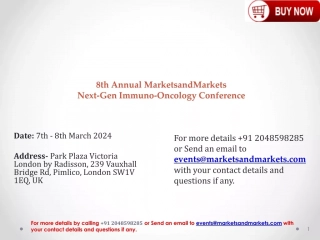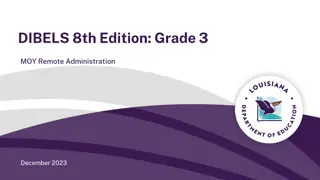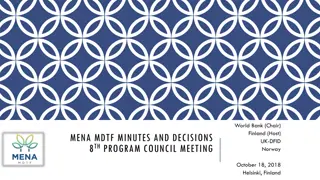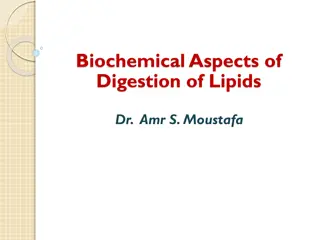
CVMP Strategy on Antimicrobials 2016-2020 Overview
Understanding the CVMP's strategy on antimicrobials from 2016 to 2020, focusing on reducing antimicrobial resistance, promoting responsible use, and ensuring effective veterinary medicines are available while mitigating risks to animals and humans. The strategy outlines measures to reduce antimicrobial consumption in animals, the role of the agency in supporting new medicines and treatment approaches, and the importance of data collection for guiding policies and research. Additionally, it discusses the regulatory landscape for antimicrobials in the European Union, highlighting the gradual phase-out of growth promoters and the prescription-only status of antibiotics. The CVMP's vision emphasizes the availability of effective antimicrobial medicines with minimal risks, and the strategy builds upon previous efforts by integrating activities within a broader EU and international context. The aim of the strategy is to provide opinions for authorizing veterinary antimicrobial products and advising on the public health risks associated with antimicrobial resistance transfer.
Uploaded on | 0 Views
Download Presentation

Please find below an Image/Link to download the presentation.
The content on the website is provided AS IS for your information and personal use only. It may not be sold, licensed, or shared on other websites without obtaining consent from the author. If you encounter any issues during the download, it is possible that the publisher has removed the file from their server.
You are allowed to download the files provided on this website for personal or commercial use, subject to the condition that they are used lawfully. All files are the property of their respective owners.
The content on the website is provided AS IS for your information and personal use only. It may not be sold, licensed, or shared on other websites without obtaining consent from the author.
E N D
Presentation Transcript
CVMP Strategy on Antimicrobials Presented by David Murphy Chair, Committee for Medicinal Products for Veterinary use (CVMP) An agency of the European Union
Content The problem of antimicrobial resistance (AMR) CVMP strategy on antimicrobials 2016-2020 Measures to reduce the need to use antimicrobials in animals One health 1
Agency role support the development of new medicines and treatment approaches; promote responsible use of existing antibiotics; collect antimicrobial consumption data to guide policy and research. Agency role 3
Background: AMs for use in animals in the European Union Antimicrobials heavily regulated: Gradual phase out as growth promoters since 70 s, complete ban in 2006. Antibiotics are prescription only. Many MSs taking action to reduce antimicrobial consumption New intended regulation of veterinary medicinal products will provide tools to tackle AMR specifically. Committee of Medicinal Products for Veterinary Use (CVMP) strategy on antimicrobials in place since 1999.
CVMP Vision Statement on antimicrobials 2016-2020 The CVMP s vision is the availability of effective antimicrobial medicines for the treatment of important infectious diseases of animals with, at the same time, minimum risks to animals or humans arising from their use. CVMP Strategy on antimicrobials 5
CVMP Strategy on antimicrobials 2016-2020 Builds on former strategies with an increased emphasis on activities of CVMP taking place within a wider EU and international context Provides the necessary strategic framework within which all activities related to AMR carried out by EMA/CVMP should take place CVMP Strategy on antimicrobials 6
Summary of the CVMP strategy Aim 1: To provide opinions for the authorisation of effective antimicrobial veterinary medicinal products ensuring that the necessary risk management measures are applied so that products can be used safely and sustainably. Aim 2: To consider and advise on the risk to public health that could arise from the use of antimicrobials due to the transfer of antimicrobial resistance from animals to humans, and to balance this against the need to protect animal health. CVMP Strategy on antimicrobials 7
Summary of the CVMP strategy (cont.) Aim 3: To maintain the effectiveness of antimicrobial substances that are already authorised in veterinary medicinal products by monitoring and analysing their sales and usage, encouraging surveillancefor changes in susceptibility of target pathogens and zoonotic bacteria, and subsequently reviewing the authorisation of substances and/or products, especially when there is evidence that there may be a related change in the benefit-risk of the authorisation. Aim 4: To encourage the development of new and existing antimicrobial veterinary medicinal products, especially in order to fill therapeutic gaps and for minor uses and minor species, and to foster the development of alternatives to antimicrobials. CVMP Strategy on antimicrobials 8
Summary of the CVMP strategy (cont.) Aim 5: To support the responsible use of antimicrobials both in accordance with Marketing Authorisations and when used outside the terms of the MA. Aim 6: Recognising that AMR is a global problem affecting both animal and human health, to work in partnership with the European Commission, international regulatory bodies, human and animal health organisations and the pharmaceutical and livestock industries to provide science led guidance on the responsible use of antimicrobials in animals. CVMP Strategy on antimicrobials 9
Other considerations of the strategy One of the most effective measures to limit expansion of AMR is an overall reduction in antimicrobial use. This is best achieved through measures to prevent infections from establishing (husbandry, biosecurity, vaccination, etc) and more targeted use of antimicrobials where it is still necessary to guard animal health (e.g. by use of accurate diagnosis, evidence-based regional treatment guidelines and correct dosing regimens) The CVMP will also support the development of veterinary medicines which reduce the need for use of antimicrobials ( alternatives ), such as vaccines. CVMP Strategy on antimicrobials 10
Measures to reduce the need to use antimicrobials in animal husbandry in the EU (RONAFA) European Commission request to the EMA and EFSA 1. Review the measures that have been, or are being taken, to reduce the use of antimicrobials in animal husbandry in the EU. 2. Assess the impact of such measures regarding the occurrence of antimicrobial resistance in bacteria from food-producing animals and food. 3. Possible alternatives to the use of antimicrobials in animal husbandry in the EU. 4. Impact of such alternative measures on the occurrence of antimicrobial resistance 5. Recommend options to reduce antimicrobial usage in animal husbandry in the EU RONAFA 11
RONAFA 12
Recommendations to reduce antimicrobial use in food-producing animals An integrated, multifaceted approach is needed: Control strategies that have been important drivers for change include setting of national targets to reduce antimicrobial use. Use should be reduced to the minimum that is necessary to treat infectious diseases .their use to prevent such diseases should be phased out in favour of alternative measures. CIAs for human medicine should only be used in animals as a last resort. Consider alternatives to antimicrobials. Implementing farming practices that prevent the introduction and spread of the disease. Education and awareness. RONAFA 13
Other considerations of the CVMP strategy AMR is an expanding global problem affecting both animal and human health. Therefore it is important thatthe CVMP continues to work with colleagues in the EU network agencies, international regulatory bodies and with its stakeholders to ensure harmonisation of regulatory frameworks and that a One Health approach is taken to the control of AMR. Collaborate with international bodies such as VICH and Codex to harmonise regulatory frameworks; Participation at Transatlantic Taskforce on Antimicrobial Resistance (TATFAR) Comments provided to the work of other international organisations as required (e.g. WHO, OIE). CVMP Strategy on antimicrobials 14
EMA supports a 'One Health' approach, promoting a close and integrated cooperation between the human and veterinary fields. EMA - AMR 15
Joint Interagency Antimicrobial Consumption and Resistance Analysis (JIACRA) Report Joint report on the integrated analysis of the consumption of antimicrobial agents and occurrence of antimicrobial resistance in bacteria from humans and food-producing animals (January 2015). http://www.ema.europa.eu/docs/en_GB/document_library/Report/2015/01/WC500181485.pdf JIACRA 16
Conclusions Antimicrobials are a key tool for the treatment of infectious diseases in animals. Focus is on ensuring availability of effective antimicrobial VMPs, while minimising risks to animal and public health associated with their use. Key message: Reduce, Refine, and Re-think Note recommendation for phasing out of preventive use of AMs Generation of good quality data to guide policy and assess impact of measures is critical (human/vet collaboration is an important element of this). Conclusions 17
Thank you for your attention Further information info@ema.europa.eu European Medicines Agency 30 Churchill Place Canary Wharf London E14 5EU United Kingdom Telephone +44 (0)20 3660 6000 Facsimile +44 (0)20 3660 5555 Send a question via our website www.ema.europa.eu/contact Follow us on @EMA_News
Total sales of veterinary antimicrobials agents for food-producing species, in mg/PCU, from 2011-2014, for 29 European countries PCU = sales corrected by the animal population (kg biomass at time of treatment). ESVAC, 2016 20
Antimicrobial use in animals in the European Union EMA ESVAC (2016) Large variation in the sales of antimicrobials across MSs, ranging from 3.1 to 418.8 mg/PCU; 91.6% of overall sales were for oral administrations (group treatment), with 42.1% of sales as premixes; Most frequently used antimicrobials were tetracyclines (33.4%), penicillins (25.5%) and sulfonamides (11.0%); Of the CIAs, polymyxins (mostly colistin) account for 6.6% of sales, fluoroquinolones for 1.9%, and 3rd-and 4th-generation cephalosporins for 0.2%; For 24 countries reporting sales data to ESVAC for the years 2011 2014, an overall decrease of 12% in sales (mg/PCU) was observed. ESVAC, 2016 21
Antimicrobial use in animals in the European Union EMA ESVAC (2016) Prescribing patterns of the various antimicrobial classes, expressed as mg/PCU, varied substantially between countries. 3rd- and 4th-generation cephalosporins, ranging from 0.01 % to 1.5 % of sales Fluoroquinolones, 0.01 % to 11.9 % and Macrolides, 0 % to 16.9 % Polymyxins, 0 % to 8.7 % ESVAC, 2016 22
Use of colistin in animals and CVMP actions In animal medicine colistin is mostly used for the treatment of enteric diseases in e.g. pigs and poultry. CVMP has concluded referrals restricting its use to treatment and metaphylaxis. Combinations of colistin + another AM - prohibited. EMA - AMR 23
Colistin - actions Reduction of use of colistin below 5 mg/PCU Ideal target; below 1 mg/kg PCU No increase in use of fluoroquinolones or 3rd and 4th generation cephalosporins No increase in overall antimicrobial use ESVAC data allows for targeted objectives. European countries and European Commission to take action EMA AMR 24
Colistin mg/PCU Sales of colistin in for use in animals in mg/PCU in 2013 (ESVAC data), including the 5 and 1 mg/PCU levels. No sales reported in Finland, Iceland and Norway. 66% and 93% of reduction respectively. EMA AMR 25






















